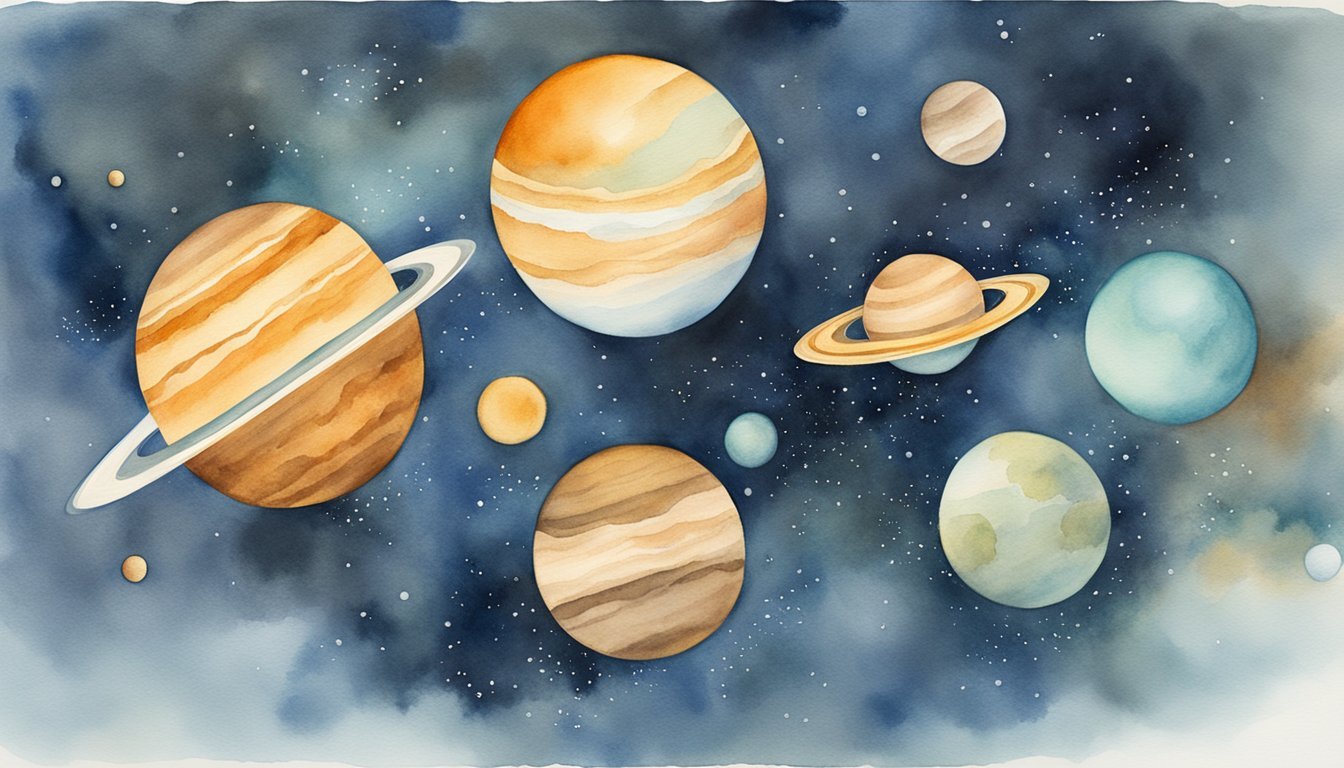Understanding Our Solar System
As we journey through our solar system, we discover a complex family of objects, from the fiery Sun at its center to the countless smaller bodies that top off its structure. Here, we outline the major categories that make up this grand cosmic dance.
The Sun: Heart of the Solar System
At the center of our solar system is the Sun, a star perpetually powering life on Earth with its nuclear fusion. This colossal ball of gas is responsible for the gravity that keeps planets, dwarf planets, comets, and asteroids in orbit.
Terrestrial Planets: Rocky Worlds
The terrestrial planets—Mercury, Venus, Earth, and Mars—are characterized by their solid, rocky surfaces. Mercury, the smallest, has a cratered landscape with temperatures that swing dramatically. Venus boasts a thick and toxic atmosphere, whereas Earth sustains life with its hospitable conditions. Mars, with the largest volcano and canyon in our solar system, hints at geological activity in the past.
Giant Planets: Gas and Ice Behemoths
Jupiter and Saturn are known as the gas giants, composed mostly of hydrogen and helium. They stand out with their impressive size and ring systems. Uranus and Neptune, the ice giants, are encased in a thick layer of gaseous and icy materials above their solid cores.
Dwarf Planets and Small Solar System Bodies
Dwarf planets like Pluto, Eris, Ceres, Haumea, and Makemake inhabit the furthest reaches of our solar system. These bodies, categorized by the International Astronomical Union, share many features with the traditional planets but lack the mass to clear their orbital paths of debris.
Asteroids, Comets, and Moons
Asteroids, found predominantly in the Asteroid Belt, are relics from the early solar system, while comets, primarily from the Oort Cloud and Kuiper Belt, are icy visitors from the outer edges. Moons orbit planets and come in a diverse range of environments, from volcanic Io to icy Europa.
Exploring Beyond the Traditional Planets
The quest to understand our place in the universe has led astronomers to look beyond our solar system’s boundaries, using powerful telescopes to discover thousands of exoplanets orbiting other stars within the Milky Way. This research offers clues to the potential for habitable worlds beyond our own.
The Life Cycle and Classification of Planets

The journey of a planet from its birth in a whirling cloud of dust to its classification among the celestial bodies is both intricate and fascinating. This section dives into the formation process, categorization, dynamics, and the tools used to expand our understanding of the planets.
From Dust to Planet: Formation and Accretion
Planets begin life within dense regions of an interstellar cloud, a collection of gas and dust known as a nebula. Over time, gravity pulls this dust and gas together, forming clumps called planetesimals. These planetesimals accumulate more material through a process called accretion, eventually growing large enough to form a planet. Through the stages of dust, nebula, and accretion, a planet reaches hydrostatic equilibrium, taking on a near-spherical shape due to its own gravity.
Planets are formed over millions of years and their ultimate size can vary greatly. The history of our solar system, for example, has seen the formation of both small rocky planets like Mercury and enormous gas giants like Jupiter.
Classifying the Celestial Bodies
The International Astronomical Union delineates clear criteria for classifying celestial bodies. A planet must orbit a star, assume a spherical shape by its own gravity, and have cleared its orbit of other debris. Contrarily, dwarf planets like Pluto, meet the first two criteria but have not cleared their orbit.
The classification catalog continues with further categories involving size, location, and composition, distinguishing between terrestrial planets, gas giants, ice giants, and dwarf planets, each with distinct characteristics in mass and density.
Planetary Motion and Characteristics
Each planet exhibits its own unique motion. They rotate on their axes, which determines the length of a planet’s day, and revolve in orbits around their respective stars, defining their years. The axis of rotation can differ significantly between planets, influencing seasonal changes and climate.
Due to the conservation of angular momentum, the rotation and orbit of a planet are remnants of the original momentum from the spinning interstellar cloud, shaping not only their day and year but also their overall spherical shape and placement within the universe.
The Quest for Understanding: Astronomy and Telescopes
Astronomers have utilized tools such as telescopes and space probes to study planets both within our solar system and beyond, in the quest to understand their origins and place in the cosmos. From ground-based telescopes to space-borne observatories, each instrument provides a unique view of the stars and planets, peering into the depths of the universe to unravel the mysteries of celestial bodies.
These advancements in astronomy coupled with historical perspectives from figures like Aristarchus of Samos have given us insights into our location within the Milky Way Galaxy and the larger cosmos, marking a remarkable journey in our understanding of the universe and our own solar system’s origins and properties.

